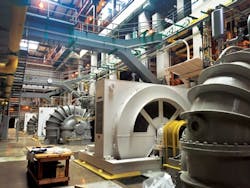About the author: Amy McIntosh is associate editor for W&WD. McIntosh can be reached at [email protected] or 847.954.7966.
Owned and operated by the Metropolitan Water Reclamation District of Greater Chicago, the Stickney Water Reclamation Plant (WRP) encompasses a 260-sq-mile service area in Cook County, serving more than 2.3 million people in Chicago and 46 neighboring communities. WEFTEC.15 attendees will have an opportunity to tour the plant as part of the annual conference and exhibition.
In total, the Stickney WRP is home to 190 buildings and spans 413 acres in Cicero, Ill. The WRP is made up of two plants: the West Side Plant and the Southwest Plant.
The West Side Plant, named for its location just west of the city of Chicago, was built in 1930, employing Imhoff tanks for primary treatment. In 1939, the Southwest Plant was built, housing a primary treatment system as well as a secondary aeration system. The aeration system originally was made of two batteries, known as batteries A and B. When it was determined that the Southwest Plant could not handle the flow from the West Side Plant, in 1947, battery C was put in place so that all flows could be treated secondarily. In 1975, battery D was installed, further increasing the plant’s capabilities.
Record-Setting Treatment
While the plant experiences an average flow of 700 million gal per day (mgd), its capacity is 1.44 billion gal per day, making it the largest wastewater treatment plant in the world.
“It’s interesting that the average-sized treatment plant in the state of Illinois treats about 1 mgd,” said Reed Dring, operations manager for the Stickney WRP. “At peak capacity, [this plant treats] 1,440 mgd, which is a million gallons a minute. I can do in a minute what the average-sized plant can do in a day.”
Water enters the facility from a combined sewer system, passes through coarse filters and then is pumped to the primary treatment system. Aerated grit and settling tanks separate the solids, and the water is pumped to secondary aeration tanks—batteries A, B, C and D—before heading to final settling tanks to remove the remaining solids. The effluent is discharged into the Chicago Sanitary and Ship Canal.
Today’s treatment process at the Stickney WRP is almost identical to the one employed when the secondary treatment system was put online nearly 80 years ago.
“I use biology; I’m not using any chemicals,” Dring said. “There are some other little changes here and there, but the basic mainstream means of treating and discharging into the canal is the same as it was in 1940. We do have new processes that are going to be coming online, such as phosphorus recovery and ammonia control in the aeration tanks. Those are different enhancements, but the basic system is the same.”
In the Works
The phosphorus recovery facility currently is under construction, with anticipated completion by the end of 2015.
“There was a push by the environmental community because of the hypoxic zone in the Gulf of Mexico and the need to reduce the phosphorus coming out of the Mississippi River into the gulf,” Dring said. “Our executive director thought that was something we could tackle.”
The centrate from the post-digestion centrifuges will undergo an Ostara nutrient recovery process that will pelletize the phosphorus and other nutrients. These pellets—each of which will be made of approximately 12% phosphorus—then will be available for reuse, such as in fertilization applications. The process is expected to produce approximately 7 tons of phosphorus per day when operations begin. After additional ancillary systems are installed, Dring expects to see up to 20 tons of phosphorus recovered per day.
Another project currently underway is the replacement of the West Side Plant’s Imhoff tanks with nine 160-ft primary settling tanks. The project, which is expected to be finished in 2018, will assist with gas production.
“Right now, when the solids go into the Imhoff tanks, the solids are volatized and the air just escapes into the atmosphere,” Dring said. “Now we’ll be able to get those solids out of the tank into the digesters and volatize it there and make more gas.” This project, along with another plan to double its methane production through the introduction of high-strength waste, is part of the plant’s ultimate goal of becoming energy-neutral.
Download: Here
